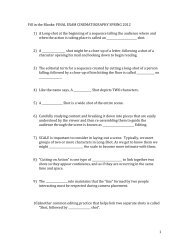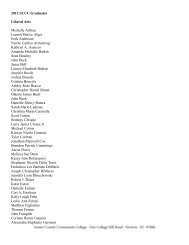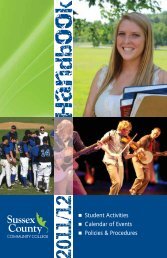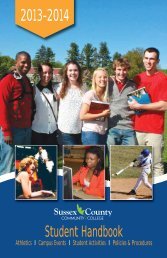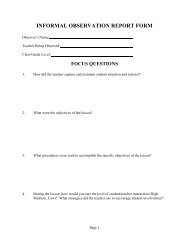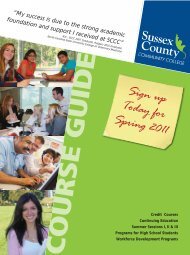Citing, Quoting Paraphrasing
Citing, Quoting Paraphrasing
Citing, Quoting Paraphrasing
You also want an ePaper? Increase the reach of your titles
YUMPU automatically turns print PDFs into web optimized ePapers that Google loves.
<strong>Citing</strong>, <strong>Quoting</strong> <strong>Paraphrasing</strong><br />
Any information you take from a book, article, website or other source<br />
must be credited to the original in your paper and work cited page. Failing to give<br />
proper credit, even unintentionally, may result in disciplinary action. Here are<br />
ways to avoid trouble.<br />
�� Find out which citation format your teacher wants you to use for<br />
papers. At SCCC, most teachers prefer the Modern Language Association format<br />
(MLA), although the American Psychological Association format (APA) is becoming<br />
popular.<br />
�� Have a source that tells you how to use citation formats. The Quick Access<br />
writing manual includes citation information. The library has books about MLA<br />
and APA formats. You can also try the following websites;<br />
Citation 101. Wellesley College General Judiciary –<br />
www.wellesley.edu/GeneralJudiciary/citation101.html<br />
<strong>Citing</strong> Sources. Duke University Libraries Research and Reference –<br />
library.duke.edu/research/citing<br />
Citation Style for Research Papers. B. Davis Schwartz Memorial Library,<br />
Long Island University –www.liunet.edu/cwis/cwp/library/<br />
workshop/citation.htm<br />
Karla’s Guide to Citation Style Guides. University of Iowa –<br />
bailiwick.lib.uiowa.edu/journalism/cite.html<br />
�� When writing your paper, know the difference between quoting, paraphrasing<br />
and summarizing. Quotations use a narrow part of a source and use the exact<br />
wording of the original. Paraphrases take a larger part of the source. The researcher<br />
condenses the information and puts it in his or her own words. In summarizing,<br />
the researcher provides a condensed version of the main points of a<br />
source in his or her own words. All three types of source usage must be attributed<br />
to the original writer (Driscoll).<br />
The following websites give helpful examples;<br />
How to Avoid Plagiarism. Academic Integrity at Northwestern University.—www.northwestern.edu/uacc/plagiar.html
Plagiarism. “Writing Center at UNC-Chapel Hill –<br />
www.unc.edu/depts/wcweb/handouts/plagiarism.html<br />
<strong>Quoting</strong>, <strong>Paraphrasing</strong> and Summarizing. OWL at Purdue –<br />
owl.english.purdue.edu/owl/resource/563/01/<br />
�� What a writer says is intellectual property. How it is said is intellectual<br />
property as well. Taking sections of a writer’s work, putting them in your paper<br />
and attributing them to the writer without paraphrasing is plagiarism. This is very<br />
easy to do when you are a beginning writer or when you are rushed.<br />
Look at this paragraph from a review by Roger Ebert;<br />
“Only enormously talented people could have made "Death to Smoochy."<br />
Those with lesser gifts would have lacked the nerve to make a film so bad, so<br />
miscalculated, so lacking any connection with any possible audience. To make a<br />
film this awful, you have to have enormous ambition and confidence, and dream<br />
big dreams.”<br />
This is an improper paraphrase;<br />
Roger Ebert said that only enormously talented people could have made<br />
"Death to Smoochy." Those with lesser gifts would have lacked the nerve to make<br />
a film so bad, so miscalculated, so lacking any connection with any possible audience.<br />
To make a film this awful, you have to have enormous ambition and confidence,<br />
and dream big dreams.<br />
The excerpt does not indicate that the humor and flair in the passage are<br />
Ebert’s work, not the researcher’s.<br />
This is a correct paraphrase;<br />
In his review of “Death to Smoochy,” Roger Ebert remarked on the irony of<br />
talented people working with great effort to produce a very bad movie.<br />
�� When you take notes on source material, include all the information you<br />
will need to cite properly; names, titles, page numbers and dates. This will allow<br />
you to cite without backtracking.<br />
�� <strong>Citing</strong> information retrieved from online sources differs from citing print<br />
sources. The library offers a guide to citing material from online databases.<br />
�� Everything on the Internet is free and open to everyone, so you don’t have<br />
to cite it, right? Wrong!! You must credit everything in your paper that is not your<br />
own work. This includes information from websites, blogs and listservs. The library’s<br />
citation guide will help you.<br />
�� Take advantage of SCCC’s tutors in the Learning Center and Open Writing<br />
Tutoring –(www.sussex.edu/learningresources/tutoring/writinglab.htm), and<br />
look at the guide to “Writing Research and Specialized Papers” —sussex.edu/<br />
learningresources/writinglab/index..htm
Work Cited<br />
Driscoll, Dana Lynn. “<strong>Quoting</strong>, <strong>Paraphrasing</strong> and Summarizing.” The OWL at<br />
Purdue. 10 September 2006. < owl.english.purdue.edu/owlresource/563/01/<br />
(24 October 2007).<br />
Ebert, Roger. “Nobody Loves These Clowns: Death is the Best Thing that Could<br />
Happen to Smoochy.” Chicago Sun-Times 29 March 2002. America’s<br />
Newspapers. Newsbank. (24 October 2007).<br />
Angela Camack<br />
6/09<br />
.






